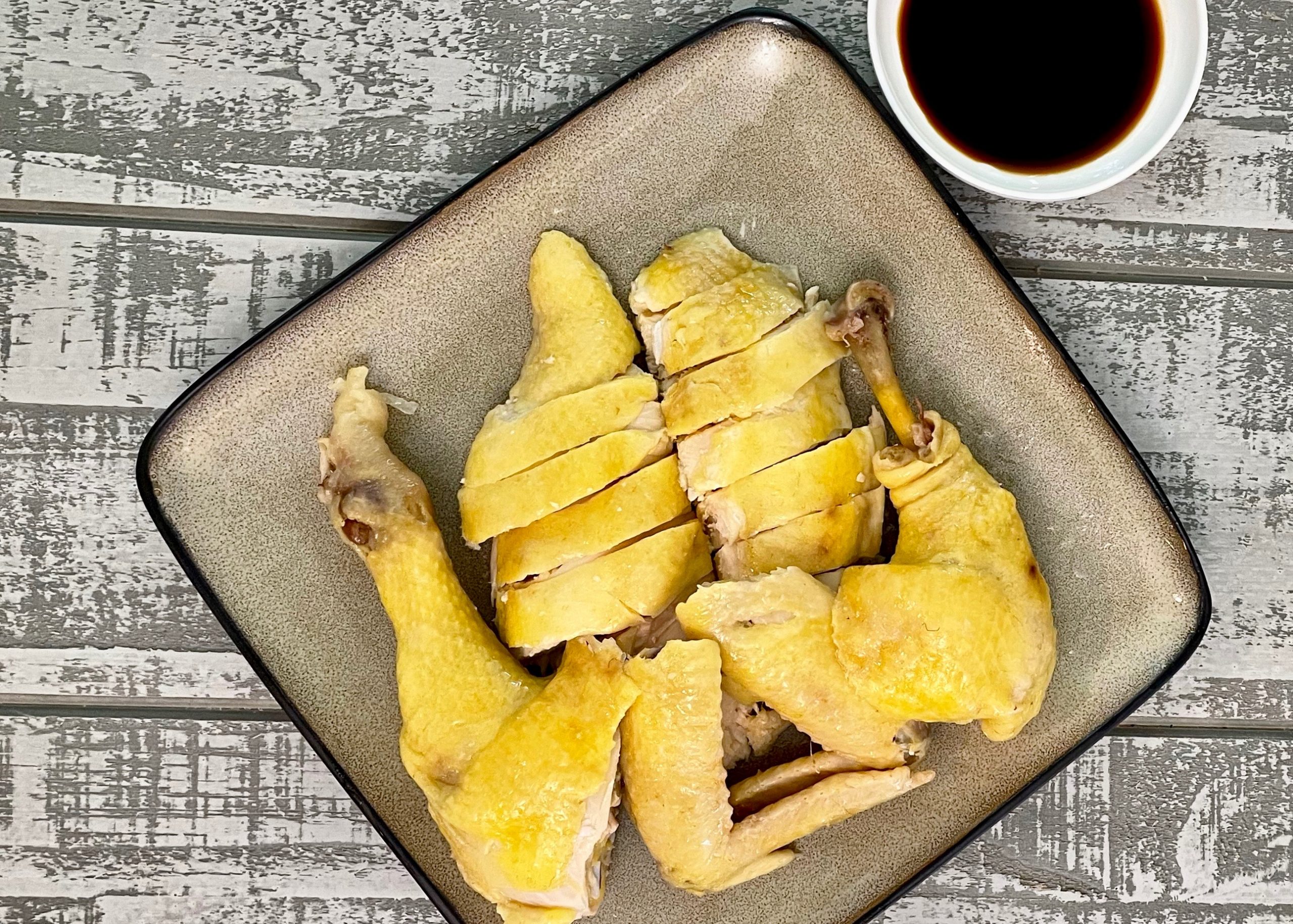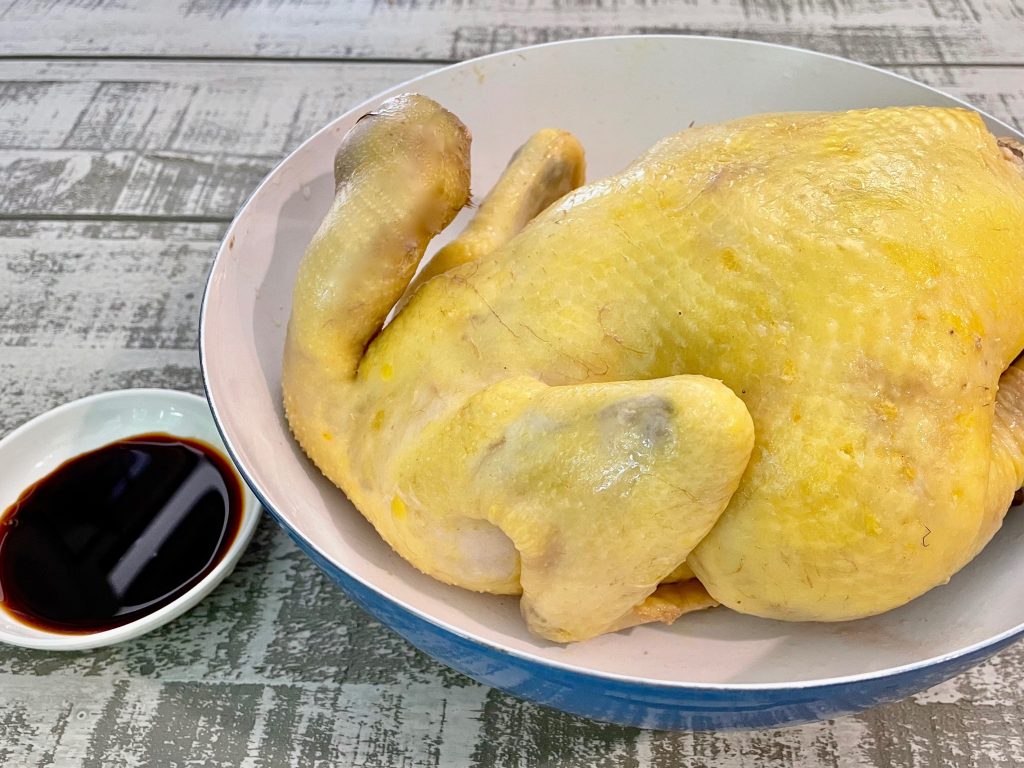CANTONESE POACHED CHICKEN

This is my favorite dish that my father makes. Growing up in Canton, there is a saying that you can’t call it a banquet without presenting chicken. Cantonese Poached Chicken (Bai Qie Ji 白切鸡)is one of the best-loved chicken dishes for family dinners.
It couldn’t be healthier or simpler: you slowly poach a whole chicken and flavor it with fresh scallions and ginger. After cooling, simply carve and serve with salted ginger scallion oil (and/or maybe a little soy sauce or honey mustard).
Serving: 6
Prep time: 10 minutes
Cook time: 50 minutes
Total time: 1 hour

Ingredients:
Chicken:
- 3-4 pound whole chicken(ideally organic free-range; optional head and feet still on; at room temperature)
- 2 green onions
- 5 slice gingers
Salted ginger green onion oil sauce:
- 3 tablespoons green onions (finely minced, white and light green parts only)
- 2 tablespoons ginger (finely minced)
- 3 tablespoons oil (preferably peanut oil)
- salt (to taste)
- soy sauce (optional)
- honey mustard (optional)
Instructions:
- Clean the chicken by rinsing it under cold water, paying special attention to the cavity. Remove any remaining organs on the inside, and pluck stray feathers. Be careful not to break or trim away any of the skin on the chicken.
- Fill a large stock pot with water, just enough to submerge the chicken completely. (see Picture 1)
- Add 2 scallions and 5 slices of ginger, and bring it to a boil. Once boiling, slowly lower the chicken into the pot, legs down and head up. It’s ok if the breast is peeking out of the water a bit. The water will cool down and stop boiling when you add the chicken, so bring it up to a boil once again, and do not walk away from the pot.
- Once the water boils again, IMMEDIATELY lift the chicken out of the water very carefully. You can carefully hook two wooden spoons under the wings to lift the chicken up. The goal is to empty any colder water that may be trapped inside the cavity. Once you’ve released that water, lower the chicken back into the pot, and bring to a boil again.
- When the water is JUST starting to boil, turn the heat down. Keep it at barely a simmer. There should be very little movement in the water, but it also shouldn’t be still. Cover the pot, and keep the heat around the lowest setting so the liquid continues to simmer slowly. Cook for about 35-40 minutes, roughly 10-11 minutes per pound. You can check to make sure the water is bubbling slowly/gently and not boiling too vigorously, but try to avoid uncovering the pot while it’s cooking.
- Poke a chopstick or skewer into the thigh to check for doneness. If the juices run clear, it’s done. Carefully lift the chicken out of the pot and transfer it to a large bowl of ice water (as cold as you can). Cool completely.
- While the chicken is cooling, make the sauce. You have the option to make two versions—one with just green onions, ginger, oil and salt, and one with soy sauce. The plain version is more traditional, as it really lets the flavors of chicken, ginger, and scallion shine through. My father always heated up the oil and add to the ginger, green onions, and salt.
- When the chicken is out of the ice water, you can brush it lightly with oil or some of the fat floating atop the poaching liquid to give it that enticing, shiny look!
- To serve, carve your chicken into pieces that you can easily grab with chopsticks. Serve with your sauce(s) and some steamed rice.
Tips and Notes:
When clean chicken, be careful not to break or trim away any of the skin on the chicken, as you don’t want the meat exposed to the boiling water as it cooks. This will ensure a moist, silky texture in the final product.
To determine the water to just enough to submerge the chicken, you can determine this by putting the entire chicken in the pot, filling it with water until the chicken is submerged, and then removing the chicken. Do not turn on the heat while the chicken is still in the pot! This method of ensuring you have just enough water to submerge the chicken (and avoiding any extra) will ensure you have a more flavorful stock to save at the end.We used about 18 cups of water to submerge a 4 pound chicken in a deep stock pot.
Don’t forget to save the chicken stock and freeze it for later! You can also use it in place of water to cook rice!
